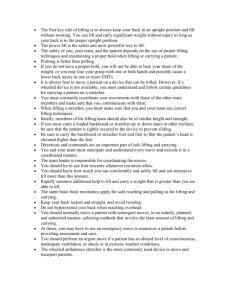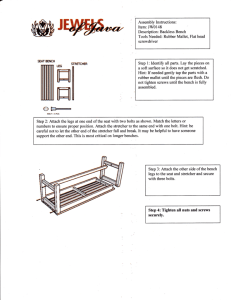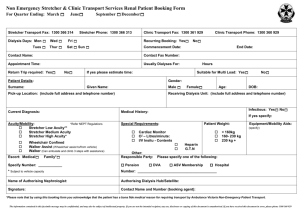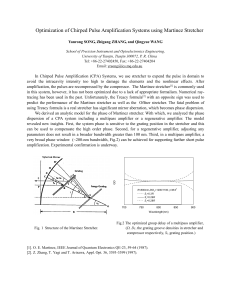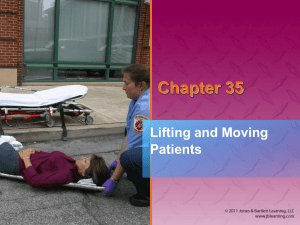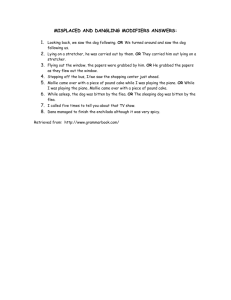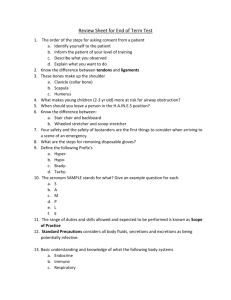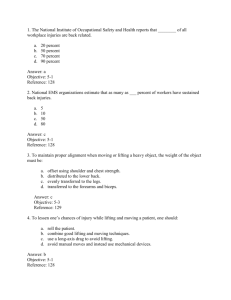Chapter 35 Lifting and moving
advertisement
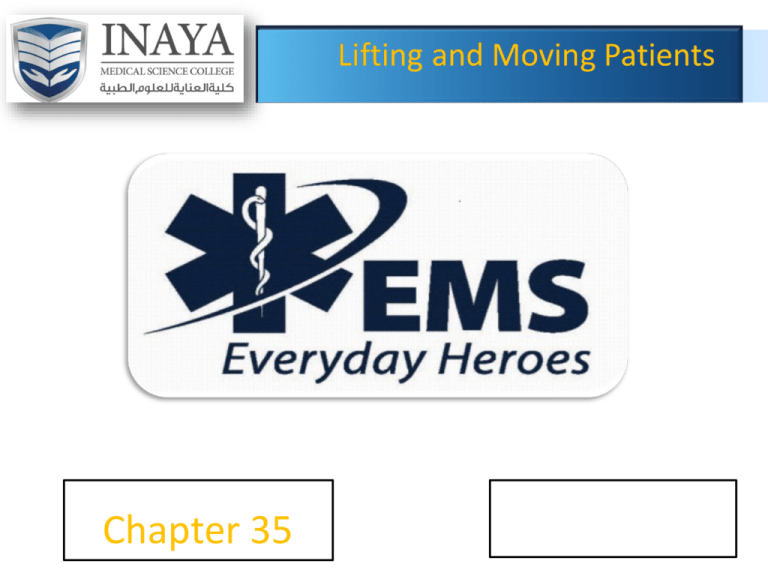
Lifting and Moving Patients Chapter 35 Introduction • In the course of a call, EMTs move patients. • To move patients without injury, you need to learn proper techniques. • Correct body mechanics, grips, and devices are important. Moving and Positioning the Patient (1 of 3) • When you move a patient, take care that injury does not occur: – To you – To your team – To the patient • Many EMTs are injured lifting and moving patients. Moving and Positioning the Patient (2 of 3) • Training and practice are required. • Special lifting and moving techniques are necessary for: – Patients with head injury, shock, spinal injury – Pregnant patients – Obese patients Body Mechanics (1 of 12) • In lifting: – Shoulder girdle should be aligned over pelvis. – Hands should be held close to legs. – Force then goes essentially straight down spinal column. – Very little strain occurs. Body Mechanics (2 of 12) Body Mechanics (3 of 12) • This is the correct way to lift. Body Mechanics (4 of 12) • You may injure your back: – If you lift with your back curved – If you lift with your back straight but bent significantly forward at the hips Body Mechanics (5 of 12) • This is an incorrect method of lifting. Body Mechanics (6 of 12) • Power lift – Legs should be spread about 15″ apart (shoulder width). – Place feet so center of gravity is balanced. – With your back held upright, bring your upper body down by bending the legs. – Grasp the patient/stretcher. Body Mechanics (7 of 12) • Power lift (cont’d) – Lift patient by raising your upper body and arms and straightening your legs until standing. – Keep the weight close to your body. – See Skill Drill 35-1. Body Mechanics (9 of 12) • Power grip gets maximum force from hands. – Palms up – Hands about 10″ apart – All fingers at same angle – Fully support handle on curved palm Body Mechanics (10 of 12) Body Mechanics (11 of 12) • To lift a patient by a sheet or blanket: – Center the patient. – Tightly roll up excess fabric on the sides. – Use the cylindrical handle to grasp fabric and lift patient. Body Mechanics (12 of 12) Weight and Distribution (1 of 9) • Whenever possible, use a device that can be rolled. • When a wheeled device is not available, a backboard must be used. Weight and Distribution (2 of 9) • More of the patient’s weight rests on the head half of the device than on the foot half. • Diamond carry and the one-handed carry use one EMT at head and foot, and one on each side of patient’s torso. – See Skill Drill 35-2 and Skill Drill 35-3. Weight and Distribution (3 of 9) Weight and Distribution (4 of 9) • Always secure patient to backboard or stretcher. – So patient cannot slide significantly when stretcher is at an angle Weight and Distribution (5 of 9) • Wheeled ambulance stretcher weighs 40–145 lb. – Generally too heavy for use on stairs Weight and Distribution (6 of 9) • If you must use a backboard or wheeled stretcher on stairs, see Skill Drill 35-4. Weight and Distribution (7 of 9) • A stair chair can be used to bring a conscious patient down to stretcher (see Skill Drill 35-5). Weight and Distribution (8 of 9) Weight and Distribution (9 of 9) • Backboard should be used instead for patient: – In cardiac arrest – Who must be moved in supine position – Who must be immobilized Directions and Commands (1 of 3) • Team actions must be coordinated. • Team leader – Indicates where each team member should be – Rapidly describes sequence of steps to perform before lifting Directions and Commands (2 of 3) • Preparatory commands are used. • Example: – Team leader says, “All ready to stop,” to get team’s attention. – Then team leader says, “Stop!” in louder voice. • Countdowns are also used. Directions and Commands (3 of 3) • Estimate patient’s weight before lifting – Adults often weigh 120–220 lb. – Two EMTs should be able to safely lift this weight. • If patient weighs over 250 lb, use four rescuers. – Place strongest EMT at head end. Principles of Safe Reaching and Pulling (1 of 4) • Body drag – When you use a body drag, same principles apply as when lifting and carrying. – Keep back locked and straight. – Kneel. – Extend arms no more than 15–20″ in front of you. Principles of Safe Reaching and Pulling (2 of 4) • Log rolling • Log roll the patient onto his or her side to place a patient on a backboard. Principles of Safe Reaching and Pulling (3 of 4) • Log rolling (cont’d) – Kneel as close to the patient’s side as possible. – Keep your back straight. – Roll the patient without stopping. Principles of Safe Reaching and Pulling (4 of 4) • Rolling the stretcher – Stretcher should be fully elevated. – Push the stretcher from the head end. – Never push with arms fully extended. General Considerations • Move a patient in orderly, planned, unhurried manner. • Carefully plan ahead. • Select methods that will involve least amount of lifting and carrying. Emergency Moves (1 of 5) • Use when there is potential for danger before assessment and management. – Examples: fire, explosives, hazardous materials • Use when you cannot properly assess patient or provide immediate care because of patient’s location or position. Emergency Moves (2 of 5) • If you are alone, use a drag to pull patient along long axis of body. • Use techniques to help prevent aggravation of patient spinal injury. – Clothes drag – Blanket drag – Arm drag – Arm-to-arm drag Emergency Moves (3 of 5) Emergency Moves (4 of 5) • To remove unconscious patient from vehicle alone: – First move legs clear of pedals. – Rotate patient so back is toward open car door. – Place arms through armpits and support head against your body. – Drag patient from seat to a safe location. Emergency Moves (5 of 5) Urgent Moves (1 of 2) • Necessary to move patient with: – Altered level of consciousness – Inadequate ventilation – Shock • Rapid extrication technique requires team of knowledgeable EMTs. – See Skill Drill 35-6. Urgent Moves (2 of 2) • Rapid extrication technique is an urgent move and should only be used if urgency exists. • Patient can be moved within 1 minute. • Technique increases damage if patient has spinal injury. • Look at all options before using technique. Nonurgent Moves (1 of 5) • Used when both scene and patient are stable • Carefully plan how to move the patient. • Team leader should plan the move. – Personnel – Obstacles identified – Equipment – Path Nonurgent Moves (2 of 5) – Direct ground lift (Skill Drill 35-7) • For those with no suspected spinal injury who are supine. • Patient will need to be carried distance. • EMTs stand side by side to lift/carry. Nonurgent Moves (3 of 5) – Extremity lift (Skill Drill 35-8) • For those with no suspected spinal injury who are supine or sitting • Helpful when patient is in small space • One EMT at patient’s head and the other at patient’s feet • Coordinate moves verbally. Nonurgent Moves (4 of 5) • To transfer a patient from bed to stretcher, use: – Direct carry (see Skill Drill 35-9) • Move supine patient from the bed to stretcher using a direct carry method. – Draw sheet method • Move patient from bed to stretcher using a sheet or blanket. – Scoop stretcher (see Skill Drill 35-10) Geriatrics (1 of 2) • Most patients transported by EMS are geriatric patients. • Skeletal changes cause brittle bones, and spinal curvatures present special challenges. • Allay patient’s fears with sympathetic and compassionate approach. Source: © Dr. P. Marazzi/Photo Researchers, Inc. Geriatrics (2 of 2) Kyphosis Spondylosis Bariatrics (1 of 2) • Refers to management of obese people • 100 million adults in the US are overweight or obese. – Approximately 20% to 25% of children are overweight or obese. • Back injuries account for the largest number of missed days of work. Bariatrics (2 of 2) • Stretchers and equipment are being produced with higher capacities. – Does not address danger to EMTs of carrying ever-heavier weights – Mechanical ambulance lifts are uncommon in United States. Patient-Moving Equipment (1 of 3) • Stretcher is available in many models with various features. • General features – Head and foot end – Strong metal frame (to push, pull, lift) – Hinges at center allow for elevation of head/back. – Guardrail prevents patient from rolling out. Patient-Moving Equipment (2 of 3) • General features (cont’d) – Undercarriage frame allows adjustment to any height. – Stretcher has locking mechanism when controls are not activated. – Controls are located at the foot end and at one or both sides of most stretchers. Types of Stretchers (1 of 19) • Wheeled ambulance stretcher – Also called a stretcher or gurney – Most commonly used device Types of Stretchers (2 of 19) • Wheeled ambulance stretcher (cont’d) – Patient may be secured directly to stretcher – Or, patient may be secured to backboard first if: • Suspected spinal injury or multisystem trauma • Patient is in need of CPR Types of Stretchers (3 of 19) • Bariatric stretcher – Specialized for overweight or obese patients – Wider wheel base for increased stability Source: Courtesy of Stryker Medical Types of Stretchers (4 of 19) • Bariatric stretcher (cont’d) – Some have tow package with winch. – Rated to hold 850–900 lb • Regular stretcher rated for 650 lb max. Types of Stretchers (5 of 19) • Pneumatic and electronicpowered wheeled stretcher Source: Courtesy of Stryker Medical – Battery operated electronic controls to raise/lower undercarriage • This increases the weight of stretcher. • Hazardous for uneven terrain or stairs Types of Stretchers (6 of 19) • Loading a wheeled stretcher into an ambulance – Ensure the frame is held firmly between two hands so it does not tip. Types of Stretchers (7 of 19) • Loading a wheeled stretcher into an ambulance (cont’d) – Newer models are self-loading, allowing you to push the stretcher into ambulance. – Other models need to be lowered and lifted to the height of the floor of ambulance. – Clamps in ambulance hold stretcher in place. – See Skill Drill 35-11. Types of Stretchers (8 of 19) • Portable/folding stretcher – Strong, rectangular tubular metal frame with fabric stretched across it Types of Stretchers (9 of 19) • Portable/folding stretcher (cont’d) – Some models have two wheels. – Some can be folded in half. – Used in areas difficult to reach – Weigh less then wheeled stretchers Types of Stretchers (10 of 19) • Flexible stretcher – Can be rolled into a tubular package – Excellent for storage and carrying – Conform around a patient’s sides – Useful for confined spaces – Uncomfortable, but provides support and immobilization Types of Stretchers (11 of 19) • Backboard – Long, flat, and made of rigid rectangular material (mostly plastic) – Used to carry and immobilize patients with suspected spinal injury or other trauma Types of Stretchers (12 of 19) • Backboard (cont’d) – Commonly used for patients found lying down – 6′ to 7′ long – Holes serve as handles and a place to secure straps. Types of Stretchers (13 of 19) • Backboard (cont’d) – Short backboards or half-boards are used to immobilize seated patients • Example: the KED vest-type device Types of Stretchers (14 of 19) • Basket stretcher – Rigid stretcher also called a Stokes litter – Used for remote locations inaccessible by a vehicle, including water rescues and technical rope rescues Types of Stretchers (15 of 19) • Basket stretcher (cont’d) – If spinal injury, secure patient to backboard and place inside basket stretcher to carry patient out of location. – When you return to ambulance, lift the backboard out of basket stretcher and place on wheeled stretcher. Types of Stretchers (16 of 19) • Scoop stretcher – Also called orthopaedic stretcher Types of Stretchers (17 of 19) • Scoop stretcher (cont’d) – Splits into two or four pieces • Pieces fit around patient who is lying on flat surface and reconnect – Both sides of patient must be accessible. – Patient must be stabilized and secured on scoop stretcher. Types of Stretchers (18 of 19) • Stair chair – Folding aluminum frame chairs with fabric stretched across to form a seat and back – Most have rubber wheels in the back Types of Stretchers (19 of 19) • Neonatal isolette – Also called an incubator – Neonates cannot be transported on a wheeled stretcher. – Isolette keeps neonate warm, protects from noise, draft, infection, excess handling. – Isolette may be secured to wheeled ambulance stretcher or freestanding. Decontamination • Decontaminate equipment after use. – For your safety – For the safety of the crew – For the safety of the patient – To prevent the spread of disease Medical Restraints (1 of 2) • Evaluate for correctible causes of combativeness. – Head injury, hypoxia, hypoglycemia • Follow local protocols. • Restraint requires five personnel. • Restrain patient supine. – Positional asphyxia may develop in prone position. Medical Restraints (2 of 2) • Apply restraint to each extremity. • Assess circulation after restraints are applied. • Document all information. Personnel Considerations (1 of 2) • Questions to ask before moving patient: – Am I physically strong enough to lift/move this patient? – Is there adequate room to get the proper stance to lift the patient? – Do I need additional personnel for lifting assistance? Personnel Considerations (2 of 2) • Remember, an injured rescuer cannot help anyone. Credits • Background slide image: © Jones & Bartlett Learning. Courtesy of MIEMSS.
